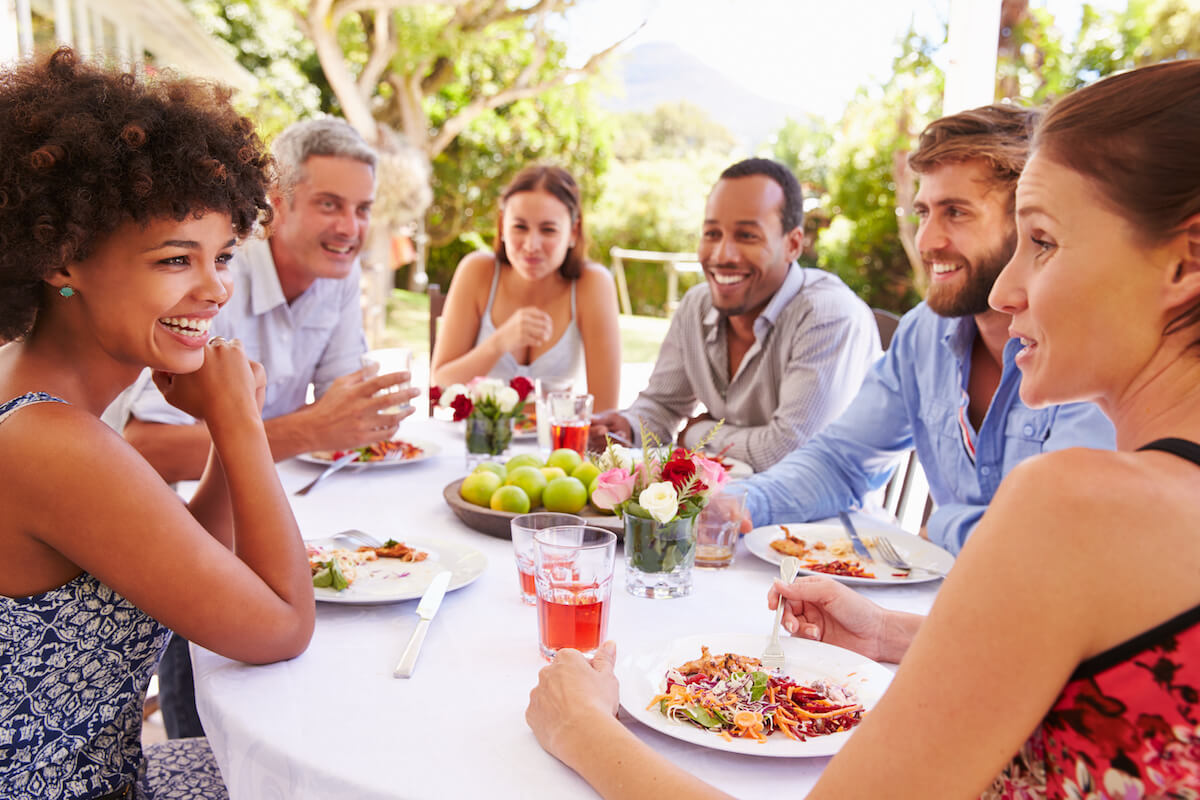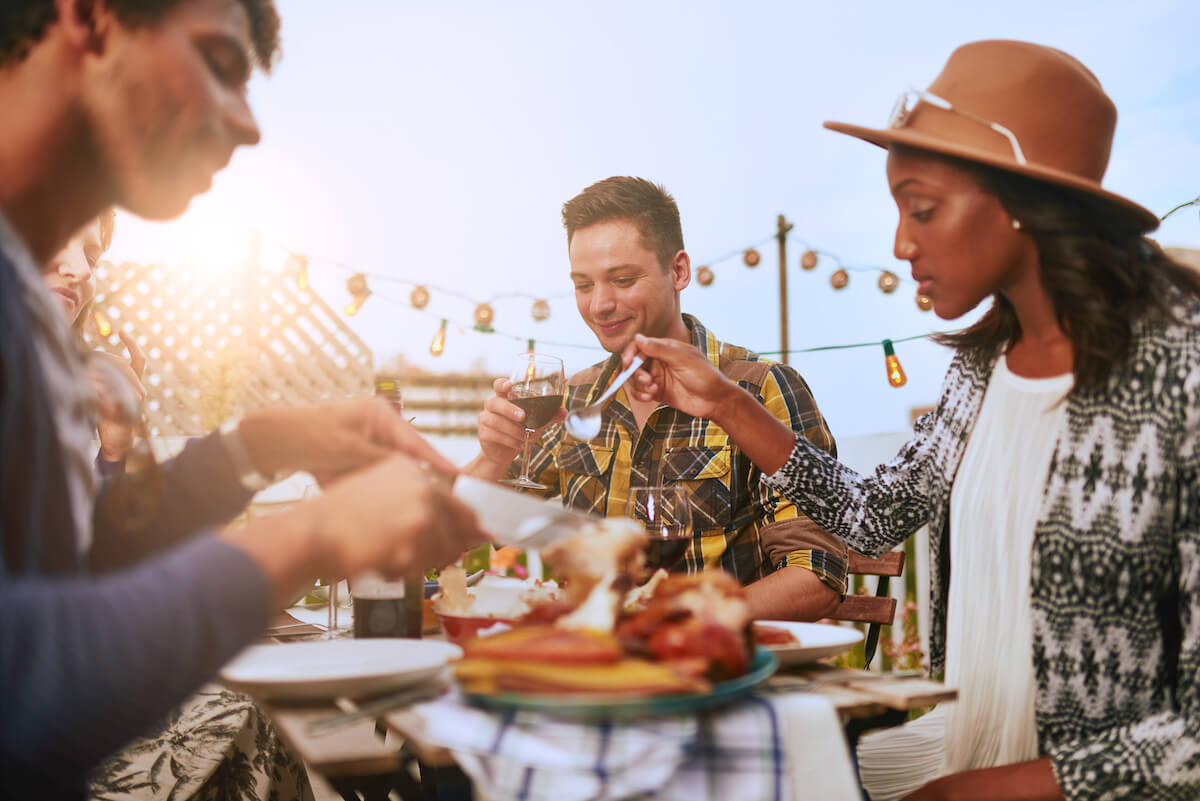Restaurant outdoor seating: Always the right season
Skip the article and turn takeaways into action by scheduling a call with our team.
Outdoor dining is undoubtedly one of the finer things in life. The tradition of great food in a beautiful outdoor space is appreciated across cultures and around the world. For diners, it can elevate a wonderful dining experience. For restaurants, outdoor seating can add allure to your establishment while expanding seating options. Luckily, there are countless ways to incorporate restaurant outdoor seating into your business.
Some restaurants are built from the ground up to include outdoor seating, capitalizing on outdoor patios with picnic tables, umbrellas, and more. Others add outdoor seating as a more ad hoc venture, claiming space where possible. Since laws regarding outdoor dining became more lax during the pandemic, urban restaurants can now take advantage of this change and add more seating capacity to walkways or parking areas.
Whatever your particular situation, adding al fresco dining can help draw in customers. You can consider restaurant outdoor seating as an extension of your dining room, or treat it as a unique space in your establishment.
So, let’s go through some of the best outdoor dining practices—taking cues from eateries worldwide but leaving plenty of room for interpretation.
Outdoor dining options: Location, location, location

How you manage and develop your restaurant’s outdoor seating will depend mostly on your location. We’ll look at a few options: Semi-urban, urban, and rural.
Semi-urban outdoor dining
“Semi-urban” isn’t necessarily a common term, but go with us here. Semi-urban restaurants have more space than their urban counterparts, but not as much as those outside city limits. We hesitate to use the term “suburban” because it implies housing developments rather than commercial space. So, imagine places that aren’t quite downtown but are still in a city and are easily accessible.
Some places like this, like Chuy’s Mexican restaurant location numero uno in Austin, are designed around their outdoor seating area. It fits perfectly with the town’s vibe and features frequent live music events, and is a perfect spot for diners to comfortably munch their tacos and sip their margaritas.
In such planned and dedicated outdoor spaces, trees and other plants are integral elements of the design. In addition to the shade and privacy they provide, the greenery adds a natural ambiance that makes people feel all the more comfortable on their large back patio.
The key element in these semi-urban restaurants is space. With ample room, adding outdoor seating is a definite winner—as long as the space isn’t right next to a freeway.
Another Austin institution that uses its open-air space well is The Draught House, a long-established beer garden and brewery whose outdoor tables have been host to countless beer lovers and long conversations. Their seating solution is simple, and it works: Picnic tables out back. That’s it. The fresh air combined with the good beer is enough to draw crowds year after year.
Urban outdoor dining
If you want a good idea of how restaurants can do urban outdoor dining right, take a note from the French and the Italians. They’ve mastered the concept of sidewalk seating: tables with umbrellas in a public setting where diners can watch the world go by. A quick Google image search for “Paris bistro” will give you an excellent idea of what this can look like—or check out any Mediterranean eatery.
While Europe has long mastered the urban outdoor dining scene, it’s definitely catching on elsewhere. New York is a city where outdoor dining laws have changed significantly. The pandemic created demand for restaurant outdoor seating, so restaurants were allowed to colonize sidewalks with tables. Restaurants previously limited by their indoor seating capacity are no longer so limited.
If you’re looking to add sidewalk seating, consider starting slowly. Adding a few tables at a time can help you manage unanticipated problems, from sidewalk obstruction to dripping air conditioners, road noise, and more. “Unanticipated” is the key word here.
In an attractive part of town, dining al fresco in an urban setting can be great fun. Restaurants can promote brunch and happy hour to take advantage of the daylight hours, especially in the warmer months.
Of course, al fresco dining isn’t simply limited to the sidewalk or patios. Rooftop bars and patios are a popular and potentially lucrative way to add space to your FOH while giving customers a pleasant place to dine. New York, again, exemplifies this outdoor dining experience, with standouts like Azul in Manhattan setting the standard for what good rooftop seating can look like. So, if you have a rooftop space, consider it some of your most valuable real estate—and supercharge it with entertainment like outdoor bars, DJs, and more.
Rural outdoor dining
If your restaurant is in a rural area, there’s a good chance you’ve got a decent amount of space around you. That space, combined with usually relaxed restaurant requirements, means your restaurant can comfortably sprawl like a cat in the sun.
Since we’ve discussed Austin establishments in this piece, check out the Salt Lick’s seating arrangement. Note the decor: Picnic tables, string lights, fire pits, and lots of trees. It’s a fine outdoor dining area and many locals’ favorite spot, and one that is easily imitated. Adding a wine bar or other outdoor bar to such an area (Salt Lick has its own vineyard) can only add to the atmosphere.
Rural restaurants can tap into the natural aspect of outdoor dining. It’s a great way to connect people to local producers via a farm-to-table menu or by offering selections from local vineyards. Naturally, you’ll want to make full use of the local environment. If you’re next to a river or lake—major score. Tables right next to a body of water make for a wonderful setting—and may be where you source clams, scallops, or fish for ceviche. Connecting with local farmers to introduce supremely fresh produce or ethically raised meat can help you stand out in your area as well.
What about winter dining?
Yes, it gets cold in the winter. That’s ok—it does not mean the end of your outdoor dining options. We’ve covered this in another piece, which we recommend you check out at this point (or when you finish this article). In short, heaters are readily available and effective. While they may cost some money up front, they quickly pay for themselves.
Ambiance, appeal, and restaurant outdoor seating

Probably the main reason people enjoy dining al fresco is because of the ambiance. Since each place has its own physical landscape, we recommend leaning into your environment when you’re developing the look and feel of your outdoor space. That way, your restaurant and outdoor dining area will look more like a natural part of the environment and will be all the more enticing.
Is a certain type of tree or flower notable in your area? Try to incorporate those. Want to add some flair to blank walls? Hire local artists to paint a mural. In effect, your restaurant can be like a flower that’s naturally sprouted from your location. The aforementioned Austin establishments make considerable use of the city’s iconic live oak trees. What’s recognizable in your area?
If your outdoor area is big enough, you’ll have ample opportunity to add to your restaurant entertainment options. This can include live music, game nights, and more. In addition to collaborating with local artists, local bands can be a significant draw for crowds. You could even arrange a festival for local musicians during warmer months. Creating opportunities for families, like art nights or skill-learning events like pottery—or even cooking—can help attract customers. These events are highly marketable on social media and can help make a name for your establishment in your community.
An extension of your front of house

Essentially, your restaurant outdoor seating extends your FOH. Whether in a semi-urban, urban, or rural environment, the best restaurants know that adding al fresco dining can be a game changer to your dining capacity and experience. Done right, it’ll help make your establishment a feature of your community.
When your FOH expands, you’ll need to ensure you’ve got the software that can back it up. Yelp’s Guest Manager can do just that—it helps streamline all FOH services and gives your staff the tools they need to get the job done right to cover both your indoor and outdoor seating.
Want to see how it works? Curious if it’s right for you? Reach out to us for a free demo. We’d love to become part of your restaurant’s landscape and help you bloom.